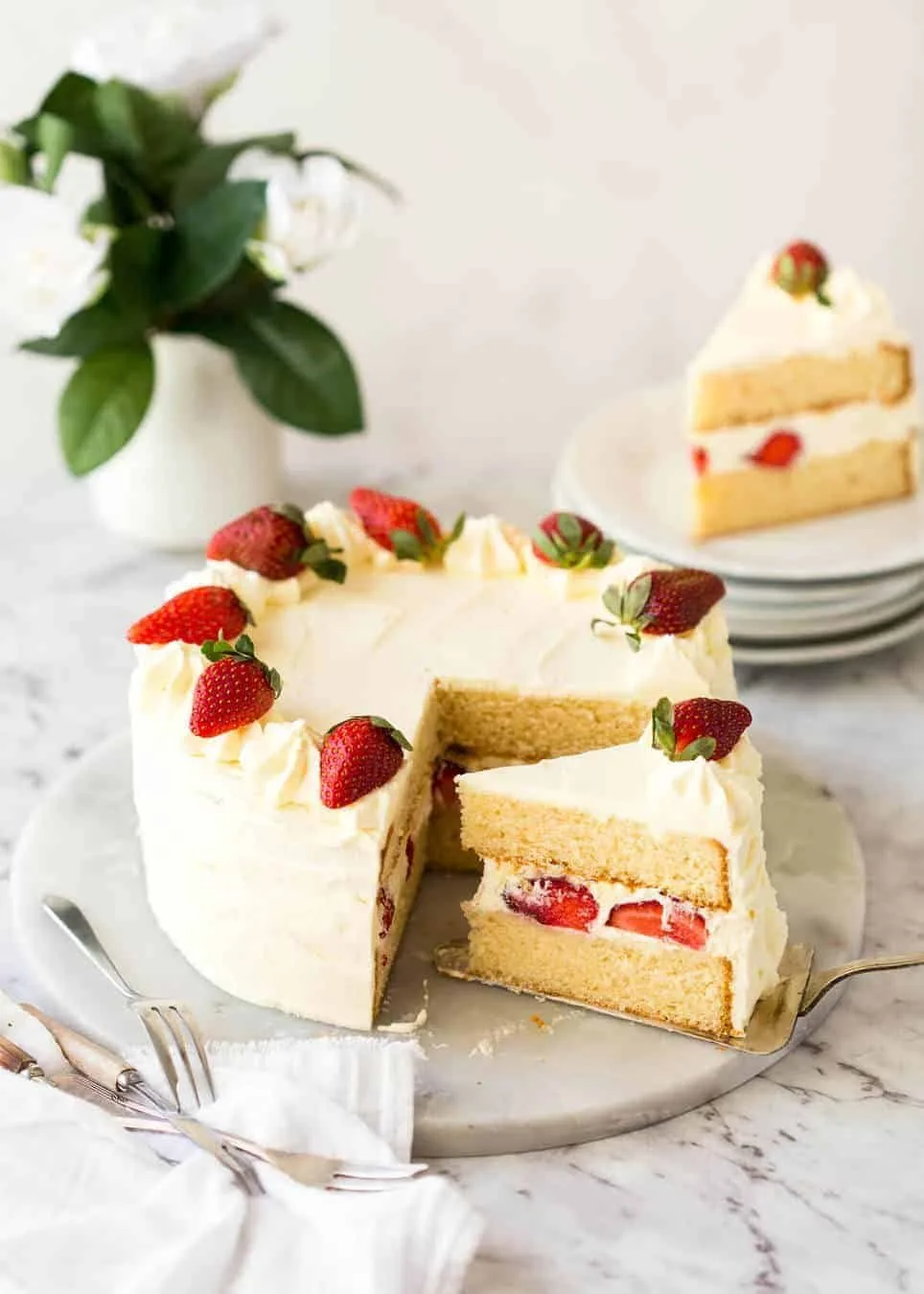Sponge Cake – Enjoy the joy of making your own sponge cake with this simple recipe. This fluffy cake is famous for its light, airy feel and its many uses. It’s perfect for special events or just a sweet craving. This guide will show you how to make a sponge cake that’s fluffy and moist, impressing everyone.
What is a Sponge Cake?
A sponge cake is a classic and loved type of cake. It’s light, airy, and delicate, made with simple things like flour, sugar, eggs, and baking powder. The secret to its spongy texture is beating the egg and butter mixture well. This adds air and makes the cake rise in the oven.
Origins of the cake
The sponge cake has a long history, starting in early European cooking. The British have a special cake called the Madeira Cake, which is basically a sponge cake. These cakes were among the first to use no yeast, relying on air to rise.
Characteristics
This cake is known for its light, airy, and soft texture. It has a delicate crumb that feels like it melts in your mouth. The beaten eggs make tiny air pockets that grow in the oven, giving it that spongy feel. Sponge cakes are great for making layer cakes, trifles, and tiramisu.
“The sponge cake is truly a wonder of baking, showcasing the power of simple ingredients and the art of incorporating air to create a truly delightful and versatile cake.”
Ingredients:
-
6 large eggs, separated
-
1 cup (210 grams) granulated sugar
-
1 cup (130 grams) all-purpose flour
-
1/2 teaspoon baking powder
Instructions:
-
Preheat your oven to 320°F (160°C). Grease and flour a 9-inch round baking pan.
-
In a large bowl, beat the egg whites until stiff peaks form. Gradually add 1/3 cup of the sugar, beating until the whites are glossy and firm.
-
In a separate bowl, beat the egg yolks with the remaining 2/3 cup of sugar until light and fluffy.
-
Gently fold the beaten egg whites into the yolk mixture, being careful not to deflate the batter.
-
Sift the flour and baking powder over the batter and fold them in until just combined, avoiding overmixing.
-
Pour the batter into the prepared baking pan and bake for 25-35 minutes, or until the cake is golden brown and springs back when touched.
-
Invert the cake onto a wire rack and let it cool completely before removing it from the pan.
| Ingredient | Quantity |
|---|---|
| Large Eggs | 6 |
| Granulated Sugar | 1 cup (210 grams) |
| All-Purpose Flour | 1 cup (130 grams) |
| Baking Powder | 1/2 teaspoon |
This simple, fluffy cake recipe provides the perfect versatile base for creating a variety of delicious cakes, such as Blackberry Lemon Cake or Tiramisu. Just be careful not to overbeat the batter and check the consistency before baking to ensure the best results. Enjoy your homemade sponge cake!
Versatility of Sponge Cake
This cake is a true culinary chameleon, offering a versatile canvas for a wide array of sweet creations. Its light, airy texture and ability to soak up flavors make it an ideal choice for many desserts.
From decadent sponge cake desserts to innovative new uses, the possibilities are endless. You can use it as the base for layered cakes, trifles, or even tiramisu. Its absorbent nature pairs perfectly with various fillings, frostings, and toppings.
You can also roll up sponge cake for cake rolls or slice it to create shortcakes or dessert cups. Its versatility shines through in every use.
Beyond traditional applications, the “first cake” can be transformed into creative recipes like French toast or cake pops. Its light texture adapts well to different flavors and textures, allowing you to experiment and get creative in the kitchen.
“The light and absorbent texture of the “first cake” makes it an ideal foundation for soaking up flavors and pairing with various fillings, frostings, and toppings.”
Looking to make a show-stopping layer cake or a quick dessert? Sponge cake’s versatility means it’s always useful in the kitchen. Embrace the endless uses for this delicious cake and let your creativity shine.
Tips and variations
Keeping your homemade “first cake” fresh is crucial for the best taste. Here are easy steps to keep your it delicious.
First, let your sponge cake cool completely on a wire rack. Don’t store a warm cake as it can become soggy. Once it’s cool, wrap it well in plastic wrap or aluminum foil to keep moisture in and air out.
For short-term, keep your the “first cake” at room temperature, wrapped tightly, for 7-10 days. Fruit cakes like carrot cake last up to 7 days. Non-fruit cakes, such as Victoria Sponge or Chocolate, can last over 10 days.
If you need to store it longer, the freezer is a great option. Wrap the cake in plastic wrap, then foil, and put it in a sealed container or bag. Frozen, your sponge cake can last up to 3 months. Thaw it in the fridge overnight before serving.
| Cake Type | Room Temperature Shelf Life | Freezer Shelf Life |
|---|---|---|
| Fruit-based (e.g., Carrot Cake) | 7 days | Up to 3 months |
| Non-fruit (e.g., Victoria Sponge, Chocolate) | 10 days | Up to 3 months |
| Wedding Cakes | N/A | Up to 6 months |
Follow these easy tips to enjoy your delicious fluffy cake for days or even months.
FAQ
What is the key to achieving a soft, spongy texture in a sponge cake?
The secret to a soft, spongy sponge cake is beating the eggs and butter mixture well. This adds air, making the cake rise in the oven.
How should sponge cake be stored to maintain its delightful, airy texture?
Let the sponge cake cool completely on a wire rack before storing. Wrap it tightly in plastic or foil to keep it fresh. For longer storage, use an airtight container at room temperature or in the fridge. Freezing is also an option, but wrap it well first.
What are the common ingredients in a sponge cake recipe?
Sponge cake recipes often include flour, sugar, butter, eggs, and baking powder. A detailed recipe might also call for olive or vegetable oil, large eggs, sugar, cake flour, and vanilla extract.
What is the origin and history of sponge cake?
Sponge cake is a classic, simple recipe from British cuisine. It’s known as the “first cake” and doesn’t use yeast for rising. This made it one of the earliest yeast-less cakes.

